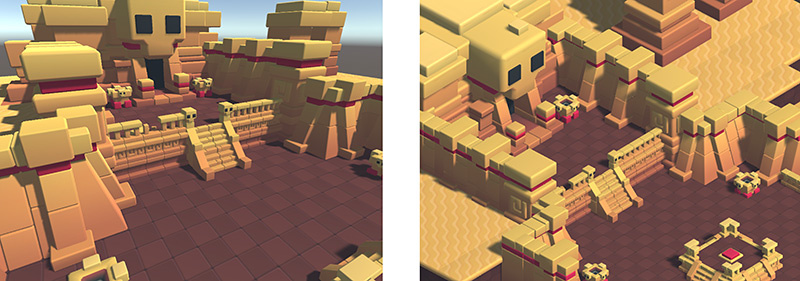Scene View Navigation
The Scene View has a set of navigation controls to help you move around quickly and efficiently.
Arrow Movement
You can use the Arrow Keys to move around the scene as though “walking” through it. The up and down arrows move the camera forward and backward in the direction it is facing. The left and right arrows pan the view sideways. Hold down the Shift key with an arrow to move faster.
Focusing
If you select a GameObject in the hierarchy, then move the mouse over the scene view and press F, the view will move so as to center on the object. This feature is referred to as ‘Frame Selected’ under the ‘Edit’ menu. However if you would like to lock the view to the object even when the object is moving then press Shift+F, this feature is referred to as ‘Lock View to Selected’ under the ‘Edit’ menu.

Move, Orbit and Zoom
Moving, orbiting and zooming are key operations in Scene View navigation, so Unity provides several alternative ways to perform them for maximum convenience.
Using the Hand Tool
When the hand tool is selected (shortcut: Q), the following mouse controls are available:
 Move: Click-drag to drag the camera around.
Move: Click-drag to drag the camera around.
 Orbit: Hold Alt and click-drag to orbit the camera around the current pivot point. This option is not available in 2D mode as the view is orthographic.
Orbit: Hold Alt and click-drag to orbit the camera around the current pivot point. This option is not available in 2D mode as the view is orthographic.
 Zoom: Hold Alt and right click-drag to zoom the Scene View. On Mac you can also hold Control and click-drag instead.
Zoom: Hold Alt and right click-drag to zoom the Scene View. On Mac you can also hold Control and click-drag instead.
Holding down Shift will increase the rate of movement and zooming.
Shortcuts Without Using the Hand Tool
For extra efficiency, all of these controls can also be used regardless of which transform tool is selected. The most convenient controls depend on which mouse or track-pad you are using:
| Action | 3-button mouse | 2-button mouse or track-pad | Mac with only one mouse button or track-pad |
|---|---|---|---|
| Move | Hold Alt and middle click-drag. | Hold Alt-Control and click-drag. | Hold Alt-Command and click-drag. |
| *Orbit | Hold Alt and click-drag. | Hold Alt and click-drag. | Hold Alt and click-drag. |
| Zoom | Hold Alt and right click-drag or use scroll-wheel. | Hold Alt and right click-drag. | Hold Alt-Control and click-drag or use two-finger swipe. |
* Not available in 2D mode.
Flythrough Mode
The Flythrough mode lets you navigate the Scene View by flying around in first person similar to how you would navigate in many games.
- Click and hold the right mouse button.
- Now you can move the view around using the mouse and use the WASD keys to move left/right forward/backward and the Q and E keys to move up and down.
- Holding down Shift will make you move faster.
Flythrough mode is designed for Perspective Mode. In Isometric Mode, holding down the right mouse button and moving the mouse will orbit the camera instead.
Note that in 2D mode, flythrough mode is not available. Holding the right mouse button down while moving the mouse allows you to pan around the scene view.
Scene Gizmo
In the upper-right corner of the Scene View is the Scene Gizmo. This displays the Scene View Camera’s current orientation, and allows you to quickly modify the viewing angle and projection mode.

You can click on any of the conical axis arms to snap the Scene View Camera to the axis it represents (eg. top view, left view, front view, etc.)
You can also toggle the projection of scene view between perspective and orthographic (sometimes called ‘isometric’) modes by clicking the cube in the centre of the Scene Gizmo, or the text below it. Orthographic view has no perspective, and it is useful in combination with clicking one of the conical axis arms to get a front or side elevation, or a plan view.


(Scene above from BITGEM)
If you manage to get your scene view into an awkward state (upside-down, or just an angle you find confusing!) you can also always shift-click the cube at the centre of the Scene Gizmo to get back to a perspective view with an angle that is looking at the scene from the side and slightly from above.
Note that in 2D mode, the scene gizmo will not be displayed since the only option is to have the view looking perpendicularly at the XY plane.
Mac Trackpad Gestures
On a Mac with a trackpad, you can drag with two fingers to zoom the view.
You can also use three fingers to simulate the effect of clicking the arms of the Scene Gizmo: drag up, left, right or down to snap the Scene View Camera to the corresponding direction. In OS X 10.7 “Lion” you may have to change your trackpad settings in order to enable this feature:
- Open System Preferences and then Trackpad (or type trackpad into Spotlight).
- Click into the “More Gestures” option.
- Click the first option labelled “Swipe between pages” and then either set it to “Swipe left or right with three fingers” or “Swipe with two or three fingers”.